MRRL Hall of Fame
Michigan Connections: JFK and The Beatles
- Details
- Category: Dr. J's Blog
- Created: Monday, 29 April 2019 07:01
- Written by Gary Johnson
The commonly held belief regarding the connection between John F. Kennedy and The Beatles is that America was in mourning following JFK's assassination in November of 1963, and The Beatles came on the scene in early 1964 and helped lift the veil of sadness that had enveloped the country. There is a great deal of truth in that, but I believe there is a lot more to the story, including some interesting Michigan connections.
Let's look at some of the aspects of the Kennedy presidency that changed America, inspired young people, and contributed in some ways to the incredible success The Beatles enjoyed in this country. 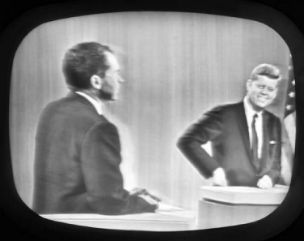 1960 Nixon and Kennedy televised debates
1960 Nixon and Kennedy televised debates
Kennedy used the emerging prominence of television in the late 1950s and early 1960s to promote his political stance and advance his policy initiatives, both at home and abroad. His televised debates in the 1960 presidential campaign with then Vice President Richard Nixon were the first of their kind, and they changed the nature of politics in America.
Without the televised debates, most historians feel that it would have been very likely that Kennedy would not have been elected. As a result, JFK can be considered the first TV president, and he ushered in the modern era in which presidential candidates absolutely must be effective television performers.
The state of Michigan played a very important role in the 1960 presidential election. Kennedy won the popular vote over Nixon in Michigan by 66,000 votes. The state's 20 electoral votes helped JFK win the Electoral College 303 to 219, although the popular vote across the nation was much closer. JFK defeated Nixon in the national popular vote by just 112,827, a margin of .017%. 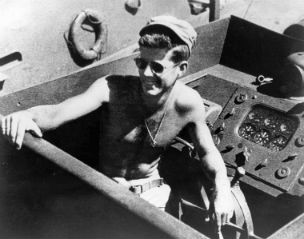 Kennedy on PT 109
Kennedy on PT 109
Kennedy was undoubtedly helped by the fact that he was a certified war hero on the famed PT 109 patrol boat during the war in the Pacific. This event was dramatized in the Hollywood film, PT 109, released in June of 1963 and starred Cliff Robertson as JFK. It was the first commercial theatrical film about a sitting United States President released while he was still in office and still alive. Watch an excellent video dealing with JFK's PT 109 experienes: https://www.youtube.com/watch?v=gUNxspgFSE4
JFK was also a very effective public speaker, and his inaugural address with its stirring challenge - "Ask not what your country can do for you – ask what you can do for your country" was the first to ever be delivered to a televised audience in color. It is considered among the best presidential inaugural speeches in American history. 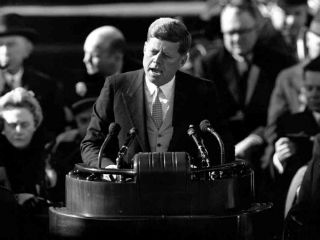 JFK's Inaugural Address
JFK's Inaugural Address
The idea of the Peace Corps first came up during Kennedy's improvised campaign speech to a cheering crowd of 10,000 at the University of Michigan in October of 1960. After Kennedy was elected, the Peace Corps was officially established in 1961 by executive order.
The Peace Corp was created with the goal of involving Americans more actively in the cause of global democracy, peace, development and freedom. Since 1961, Michigan has supplied 7,518 volunteers to the organization, including 266 who are currently serving.
JFK captured the imagination of Michigan and the rest of the country in 1961 when he began a dramatic expansion of the U.S. space program and committed the nation to the ambitious goal of landing a man on the moon by the end of the decade; a goal that was achieved by the Apollo 11 manned mission on July 20, 1969.
Kennedy also reorganized a federal physical fitness program that had been a failure under President Eisenhower and developed a new council to oversee and market a new fitness program for Americans. During the 1961-1962 school years, JFK developed a physical fitness pilot project for schools across the country. 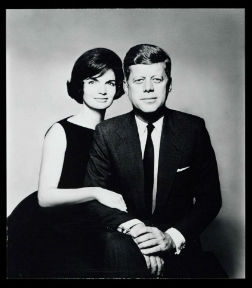 Jacqueline and John F. Kennedy
Jacqueline and John F. Kennedy
John F. Kennedy was youthful, good-looking, quick-witted, and charming. In addition, his lovely wife Jacqueline became a female fashion icon, and she took the nation on the first televised First Lady Tour of the White House in 1962. The press loved the Kennedys, and his presidency was compared by some to the fabled perfection of the kingdom of Camelot, of King Arthur legend.
Kennedy inspired many by supporting the movement for black equality. By the spring of 1963, he had come to see the struggle of African Americans as a moral one. In June, Kennedy called for the passage of a Civil Rights bill that would outlaw discrimination in public accommodations, strengthen voting rights, and enforce equal employment for all. Although Kennedy's civil rights efforts were cut short by his assassination, Lyndon Johnson was able to push through the Civil Rights Act of 1964 and the Voting Rights Act of 1965.
JFK's murder on November 22, 1963, may have been one of the most significant events that shaped modern history. One important aspect of this was the TV coverage of his assassination, especially the coverage by CBS. The tragic event ushered in the era of live television news. When CBS went on the air for three solid days of coverage, everyone realized for the first time the power of TV as a journalistic medium. Before that, newspapers and radio were the dominant forms of news. 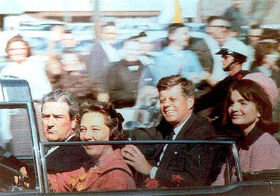 November 22, 1963
November 22, 1963
During the 1,000 days that Kennedy served as president, he appealed to young people in a way no other U.S. president ever had; and according to some schools of thought, when The Beatles came along, they tapped into the same youth market that Kennedy had connected with.
In that context, both Kennedy and The Beatles could be seen as attractive, refreshing alternatives to the status quo. Kennedy was to Richard Nixon in 1960, as The Beatles in 1964 were to Lawrence Welk. According to some scholars, what they both represented was very similar: a rejuvenation of American life and culture. They both made you feel that you could change things for the better.
As stated earlier, the link between JFK's assassination and The Beatles arrival in America involved the state of mourning the country had entered into following the death of the President. According to many cultural historians, it helped make Americans, both young and old, experience The Beatles like a cathartic blast of joy. In February 1964, The Beatles were not just a band – they were a national anti-depressant.
The Fab Four is rightfully given credit for helping lift the country out of the numbing grief following the Kennedy assassination, which happened just two and a half months before the Beatles' arrival in America. Tommy James, age 72, was born in Ohio but grew up in Niles, Michigan, where he formed The Shondells. His band would go on to record a cover of "Hanky Panky" at a local radio station, and it would become the first Michigan garage rock single to reach # 1 on the Billboard Hot 100. "After the JFK assassination in 1963, The Beatles were the only thing that made 1964 bearable," James recalled. "They also caused my generation to take a much deeper look at what was happening in the world."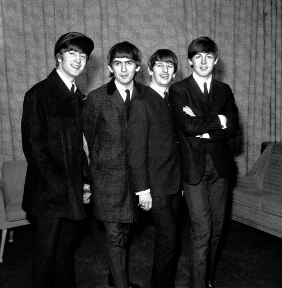 John Lennon, George Harrison, Ringo Starr, Paul McCartney
John Lennon, George Harrison, Ringo Starr, Paul McCartney
Although true, these accounts overlook the earlier connections between The Beatles and America that occurred while JFK was still alive, some of which involve Michigan.
The very first Beatles' record to be released in the U.S. was "Please Please Me". It was the band's first big hit in England, reaching # 2 in January of 1963, but Capitol Records declined to issue it in America. As a result, the song was placed with Vee-Jay Records who released it in the U.S. in February of 1963.
This very first Beatles' record to be sold in America was manufactured at the American Record Pressing plant, located in Owosso, Michigan. The record did not chart in the U.S., but the first batch of 45s that were pressed there are collector's items because a mistake was made in the spelling of the group's name – "Beattles" with two t's! 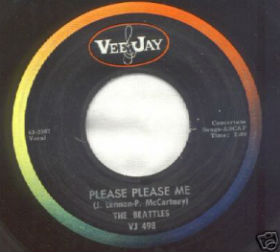 ARP 45 misspelled "Beattles"
ARP 45 misspelled "Beattles"
The American Record Pressing plant also had the distinction of pressing the very first Motown 45, "Come To Me" by Marv Johnson, on the Tamla label. Berry Gordy Jr. and Smokey Robinson drove to Owosso in the winter of 1959 to pick up the first boxes of the single. Gordy had borrowed $800 from his family to start the label, and he was operating his business from his apartment on Gladstone St. in Detroit at this time.
During the 1960s, Motown grew and became American Record Pressing's most important customer – representing about 80% of its business. After Motown had moved its operation to California in 1972, the American Record Pressing plant burned down under suspicious circumstances. 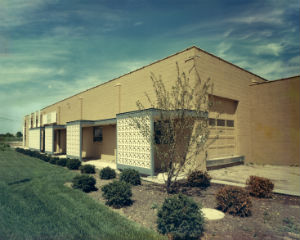 American Record Pressing in Owosso
American Record Pressing in Owosso
The Beatles' third single in England, "From Me To You" was their first # 1 hit in that country. The song also became the first song written by John Lennon and Paul McCartney to chart in the Billboard Hot 100 in the U.S. when it was covered by Michigan's Del Shannon in the summer of 1963 and reached # 73.
Vee-Jay Records was located in Chicago, and American Record Pressing in Owosso was one of the label's main pressing plants. The Beatles' original version of "From Me To You" had been pressed at ARP and released on Vee-Jay in May 1963 with "Thank You Girl" as the B-side; but it had sold even less than "Please Please Me". 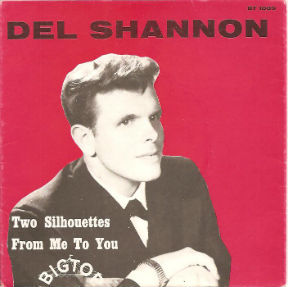 Del Shannon
Del Shannon
After Del Shannon's cover version charted a month later, Vee-Jay attempted to stimulate interest in The Beatles' version by placing magazine ads in Cash Box for "From Me To You" with the words 'The Original Hit'.
The strategy worked to a certain extent as "From Me To You" by The Beatles was added to the playlist of KRLA in Los Angeles and stayed on the radio station's chart for six weeks. Because of the airplay and sales in Los Angeles, "From Me To You" made the Bubbling Under portion of the Billboard chart for three weeks, peaking at # 116 in August. Its appearance enabled ARP in Owosso to also lay claim to manufacturing the first Beatles' single to chart in the United States.
Most Americans think that the first glimpse of The Beatles on television in this country was either on the Jack Parr Program or the Ed Sullivan Show in early 1964. But in what can only be described as an eerie coincidence, the very first appearance by The Beatles on American TV was on the CBS Morning News, hosted by Mike Wallace, on November, 22, 1963 – the very same day that JFK was assassinated. 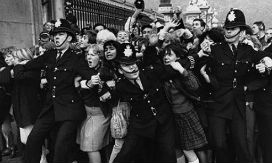 Beatlemania in England
Beatlemania in England
The Beatles' manager, Brian Epstein, had been lobbying television networks to do a story on the band as the word "Beatlemania" began spreading across British newspapers. CBS News London correspondent Alexander Kendrick decided to take a look, and he filed a report on the phenomena that included some live performance footage of the band along with a backstage interview.
Kendrick's story from what he called "Beatleland", included the band playing their latest hit single, "She Loves You", in the British seaside resort of Bournemouth. Panning the crowd, CBS cameras captured the screaming teens in what Kendrick, condescendingly, described as an "epidemic" that had seized the population, especially females. 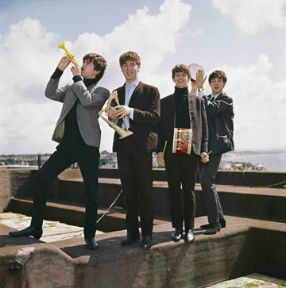 The Beatles in Bournemouth
The Beatles in Bournemouth
Backstage, The Beatles were philosophical about their rising fame. When asked if they feared that their fans would tire and move on, John Lennon replied, "They probably will but it depends on how long it takes for them to get tired"; and George Harrison added, "It's not worth missing your sleep for, is it?"
The piece debuted on CBS Morning News with Mike Wallace on the morning of November 22, 1963. It was slated to run again that night on the CBS Evening News with Walter Cronkite, but it was preempted by the assassination of President Kennedy.
Weeks later, on December 10th, Walter Cronkite aired Kendrick's report on The Beatles. Ed Sullivan watched the broadcast and called Cronkite immediately after his program, setting in motion what were to become The Beatles' historic appearances on The Ed Sullivan Show in February of 1964. Watch the entire Kendrick report on The Beatles originally shown on CBS on November 22, 1963. https://www.youtube.com/watch?v=3w3DZJmMDWU&t=260s
Sullivan was beaten to the punch, however, by Jack Parr on his Friday night prime time NBC show, The Jack Parr Program. Parr had seen the Beatles in the fall of 1963 on British television and purchased some concert footage of the group from the BBC. He featured it on his TV show on January 4, 1964, a month before The Beatles were scheduled to appear on The Ed Sullivan Show, infuriating Sullivan in the process. 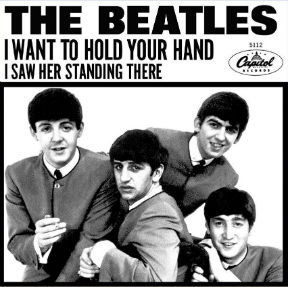 First # 1 hit in America
First # 1 hit in America
"I Want To Hold Your Hand" had just been released in America on Dec. 26th, and the song was all over the radio when Parr's program aired. I was at a house party with my fellow seniors from St. Joseph High, and I remember that the party stopped and everyone crowded around the black and white television set to get their first look at The Beatles. Although Parr poked fun at the band and their fans, everyone at the party realized we were seeing something special.
Four weeks later with "I Want To Hold Your Hand" topping the charts, The Beatles arrived at the JFK Airport on Friday February 7th to thousands of screaming fans and then to a crowded news conference in the Pan Am lounge with 200 hard-boiled reporters.
The reporters had been waiting for hours and were grumbling about their lousy assignment. What they got instead was an hour-long collection of witty quips, clever comebacks, and improvised comedy routines that made for great copy. Like John F. Kennedy, The Beatles had an innate ability to charm an audience.
The Beatles appeared on The Ed Sullivan Show for the first time on Sunday, February 9th. The program was watched by an all-time record audience of 73 million. The show remains a landmark in television history, perhaps the single most notable moment in the history of rock and roll, and an indelible memory for all who watched the historic performance. 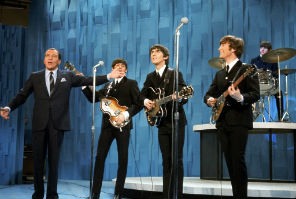 Ed Sullivan introduces The Beatles
Ed Sullivan introduces The Beatles
The Beatles appeared on The Ed Sullivan Show for three consecutive weeks and, in the process, became the world's first television band, much in the way that JFK had become the first television president.
They kicked off what became known as the British Invasion and helped introduce to American audiences a host of British bands including The Animals, the Dave Clark Five, The Kinks, The Yardbirds, The Zombies, and The Rolling Stones.
The incredible success of the Beatles on TV also inspired ABC to start a prime-time pop music show called Shindig and NBC to produce one called Hullabaloo. Dick Clark also created a weekday afternoon pop music program called Where The Action Is, with performers lip-synching their latest hits, as a spin-off to American Bandstand. 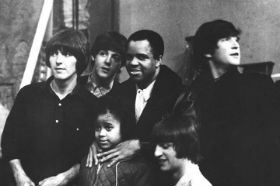 Beatles with Berry Gordy and daughter Hazel at Hitsville
Beatles with Berry Gordy and daughter Hazel at Hitsville
Although they were not directly involved in the Civil Rights movement, The Beatles were big fans of American R&B music and especially Motown and its roster of artists. "The Beatles Second Album" from 1964 contained covers of hits by The Marvelettes, The Miracles, and Barrett Strong; and The Beatles visited Hitsville U.S.A. during one of their concert appearances in Detroit.
Earning the seal of approval from the British band was an important factor in helping Motown achieve its breakout in 1964; a year when Michigan's most important black-owned record label became both a national and international success. 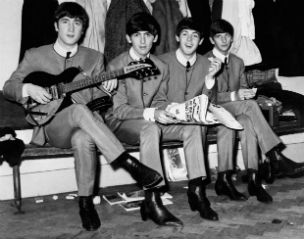 Fab Four Fashion: collarless jackets, long hair, tight slacks, and Beatle boots
Fab Four Fashion: collarless jackets, long hair, tight slacks, and Beatle boots
Much as Jacqueline Kennedy became a fashion influence for females in the 1960s, The Beatles' appearances on stages, album covers, television, and movies brought about some fashion changes for males in America. These included the collarless suit, the Cuban-heeled "Beatle" boots, tight slacks, and, most famously, the longer hairstyle.
The crew cut ruled before The Beatles, or men wore their hair combed back or parted to the side. The Beatles early dos were much longer, combed down over their foreheads but barely touching their ears. But some change is difficult, and this new style in boys' hair was not immediately accepted by adults in Michigan.
Bay City's Public Schools had a strict grooming code, and the start of the school year in September of 1965 at Bay City Central was clouded in controversy. Senior John Hale and sophomore Tom Smith were expelled from Central for coming to school with hair lengths that were considered in violation. The boys argued that they were members of a teenage rock and roll band called The Epics, and the hairstyles, pictured here, were part of their image. 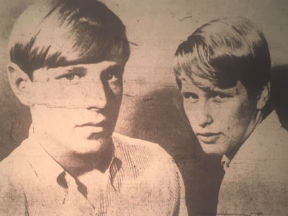 The "inappropriate" hairstyles of Tom Smith and John Hale in the fall of 1965
The "inappropriate" hairstyles of Tom Smith and John Hale in the fall of 1965
But Central's administration had the final word on the need for enforcing the rules, especially on hair length: "We feel that an improved teaching-learning situation will prevail if students attending senior high school are dressed and groomed in a manner appropriate to conventional business attire," claimed Principal Theodore B. Southerland.
Despite protests from fellow students and the support of the boys' parents, the school's hardline standards prevailed; and both Hale and Smith were expelled for the rest of the school year for their "inappropriate" hairstyles.
Besides being fashion inspirations, The Beatles helped make the U.S.A. a guitar nation. Their basic lineup of three guitars and drums changed the cultural perception of what a band was and inspired countless groups of young people to pick up guitars and form bands in basements and garages in Michigan and all over the country. As a result, guitar sales in the United States grew from 300,000 in 1958 to 1,500,000 in 1965. 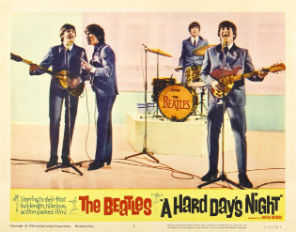 A Hard Days Night
A Hard Days Night
The members of the Beatles were also the first rock and roll artists to star as themselves in a feature film. A Hard Day's Night was musical comedy filmed in a mock documentary style at the height of Beatlemania in 1964. It is credited as being one of the most influential of all musical films, inspiring The Monkees television show and numerous film comedies and pop music videos in the late 1960s and beyond. Watch the trailer for A Hard Day's Night: https://www.youtube.com/watch?v=Pbg8T9r1DiQ
When Jim McGuinn, Gene Clark, and David Crosby saw the film in California, they were already harmonizing on folk songs using a Beatle beat. Impressed with the Beatles' hair, boots, and clothes in A Hard Day's Night, they adopted the look and added Chris Hillman on bass and Michael Clark on drums to form a band called The Byrds, one of the most successful groups directly inspired by the Beatles. 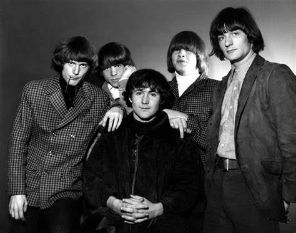 The Byrds - Jim McGuinn on left
The Byrds - Jim McGuinn on left
McGuinn was also fascinated by the 12-string electric guitar that George Harrison had in the film and quickly purchased one. It became the signature sound of the band, and The Byrds had a # 1 hit in 1965 with their folk-rock version of Bob Dylan's "Mr. Tambourine Man". The group performed it at Band Canyon in Bay City in July of 1965 on their first U.S. tour.
Prior to joining the Byrds, Jim McGuinn had written new words to the traditional folksong, "He Was A Friend Of Mine" on the night of November 22, 1963, to lament the death of President Kennedy. Some of McGuinn's revised lyrics - "He never knew my name. Though I never met him, I knew him just the same. He was a friend of mine" - referred to the fact that Kennedy's charisma was such that young people thought of him as a friend. The Beatles appealed to the nation's youth in much the same way. 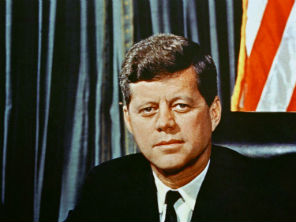 "He Was A Friend Of Mine" was a tribute to JFK
"He Was A Friend Of Mine" was a tribute to JFK
The Byrds didn't record McGuinn's song until the fall of 1965 for inclusion on their second album, "Turn! Turn! Turn!". The band appeared at Daniel's Den in Saginaw on December 5th, the day before their new album was to be released. By that time, "He Was A Friend Of Mine" had already become a regular part of the Byrds' set list, and they performed the song at Daniel's Den. It was probably the first time anyone in Michigan had heard their heartfelt tribute to JFK. Watch a very nice tribute to JFK using "He Was A Friend Of Mine" by The Byrds: https://www.youtube.com/watch?v=kUxH8DgMuMU